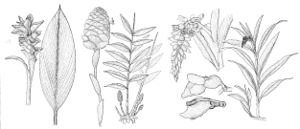Difference between revisions of "Curcuma zedoaria"
Transactions of the Linnean Society of London 8: 354. 1807.
Common names: Zedoary
Basionym: Amomum zedoaria Christmann in G. F. Christmann and G. W. F. Panzer, Vollst. Pflanzensyst. 5: 12. 1779
Synonyms: Curcuma pallida Loureiro
Treatment appears in FNA Volume 22.
FNA>Volume Importer |
FNA>Volume Importer |
(No difference)
| |
Revision as of 21:00, 16 December 2019
Leaf blades narrowly ovate or elliptical, 45–67 × 15–22 cm. Inflorescences erect, 11–23 × 5–10 cm; bracts of main axis whitish proximally, green (proximal bracts) or pink (distal bracts) distally; proximal bracts ovate to rectangular, deeply saccate, 4–4.5 × 4 cm, apex obtuse or truncate-apiculate; distal bracts narrowly ovate, 8–9 × 4–4.5 cm, apex rounded. Flowers: perianth white or spotted with purple; staminodes pale yellow with yellow streak down center of lip.
Phenology: Flowering spring (May).
Habitat: Disturbed lakeshore
Elevation: 50 m
Distribution

Fla., native, Asia (ne India).
Discussion
Curcuma zedoaria is grown commercially in Asia for its starchy rhizome, which is used as a condiment or tonic.
Selected References
None.
Lower Taxa
None.
